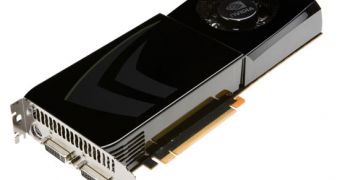During the International Consumer Electronics Show in Las Vegas, Nevada, at the end of last week, NVIDIA showcased its biggest performance graphics card to date, the dual-GPU GeForce GTX 295, which is equipped with two 55nm-based graphics processors. Just one week after the launch of the highest performance graphics card on the market, the Santa Clara, California-based chip maker finally decided to officially unveil its new single-GPU flagship model, the GeForce GTX 285, one of its highest-anticipated products.
NVIDIA's new GeForce GTX 285 comes with a new 55nm GT200 graphics processor and with a core clock of 648MHz. The card's shader clock has been rated at 1476MHz, while the memory clock is featured at 1242MHz. The GTX 285 boasts 1GB of GGDR3 memory with a 512-bit memory interface, offering a memory bandwidth of 159GB/s. A total of 240 shader cores are available, alongside 32 ROP units and 80 filtering units, features that haven't been changed from the company's GeForce GTX 280 graphics card, released back in June last year.
As it was to be expected, with the official word from NVIDIA, most of the company's board partners have rushed to announce their own GeForce 285 graphics cards. EVGA, BFG, XFX, Gainward, Inno3d, Leadtek and others are now ready to provide their customers with their own GeForce GTX 285 designs. BFG actually goes the extra mile and will only provide its customers with factory overclocked versions of NVIDIA's latest graphics card. Enthusiasts will be able to choose from four overclocked versions of the new card, each one offering a different level of performance.
With the announcement, a series of reviews have surfaced the web, putting the card through its paces. The GeForce GTX 285 comes exactly where users might have already expected it to be, namely between the GeForce GTX 295 and NVIDIA's highest performance 65nm-based graphics card, the GTX 280. The general belief is that the Santa Clara, California-based chip maker has managed to keep its promise and provide users with the fastest single-GPU graphics solution on the market. However, the difference between the GTX 280 and GTX 285 isn't that big and users are likely to go for the now lower-priced GTX 280. Moreover, with AMD slashing the price tag of its Radeon HD 4870 X2 card, the competition is still high, as the company still appears to be offering the best value for money ratio.
NVIDIA has certainly put out two new cards designed for the high-end and enthusiast market segment, but the green company still has a strong competitor in AMD's current range of Radeon graphics cards. In addition, the latter is expected to unveil its next-generation graphics drivers, the Catalyst 9.1, which could further push the performance of the company's current cards.

 14 DAY TRIAL //
14 DAY TRIAL //